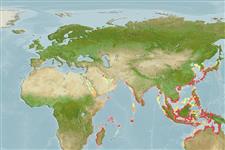Common names from other countries
Classification / Names / Names
Common names | Synonyms | Catalog of Fishes (gen., sp.) | ITIS | CoL | WoRMS
Environment: milieu / climate zone / depth range / distribution range
Ecology
Benthic; depth range 0 - 20 m (Ref. 356), usually 0 - 20 m (Ref. 75831). Tropical; 41°N - 27°S, 32°E - 143°E
Indo-West Pacific: from East Africa to the Philippines; north to Japan and south to Indonesia.
Length at first maturity / Size / Weight / Age
Maturity: Lm ? range ? - ? cm Max length : 10.3 cm SHL male/unsexed; (Ref. 126241); common length : 6.0 cm SHL male/unsexed; (Ref. 348)
Found in intertidal areas in sand and mud (Ref. 75831). Feeds on plankton and detritus (Ref. 107085). Adapted to less saline environments (Ref. 127106).
Life cycle and mating behavior
Maturity | Reproduction | Spawning | Eggs | Fecundity | Larvae
Members of the class Bivalvia are mostly gonochoric, some are protandric hermaphrodites. Life cycle: Embryos develop into free-swimming trocophore larvae, succeeded by the bivalve veliger, resembling a miniature clam.
SAUP Database. 2006. (Ref. 356)
IUCN Red List Status (Ref. 130435)
CITES status (Ref. 108899)
Not Evaluated
Not Evaluated
Human uses
Fisheries: commercial
| FishSource | Sea Around Us
Tools
Internet sources
Estimates based on models
Preferred temperature
(Ref.
115969): 24.2 - 29.2, mean 28.2 (based on 1468 cells).
Resilience
High, minimum population doubling time less than 15 months (K=0.47).
Vulnerability
Low vulnerability (10 of 100).
